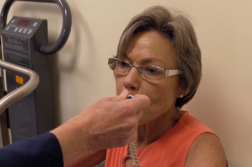ORLANDO, Fla. (Ivanhoe Newswire) — February is not only about flowers and chocolate, but it is also American Heart Month. Ivanhoe has the heart health myths you should know to protect your heart this valentine.
Heart disease is the leading cause of death, globally. In the U.S., someone dies from heart disease every 36 seconds.
“A lot of people suffer from heart failure, over five million Americans in any given year will be diagnosed with heart failure,” explained Joshua Larned, MD, Medical Director of Heart Failure Services at Holy Cross Hospital
There is a lot is misinformation about heart disease. One of the biggest is it only affects older people. But up to ten percent of heart attacks happen in people under the age of 45. The second myth is that heart disease only affects men. Heart disease is the leading cause of death for men and women. In fact, about five percent of women are likely to be misdiagnosed when they go to the hospital with a heart attack, compared to three percent of men. And our last myth: heart disease is colorblind. Heart disease takes a heavier toll on minority groups.
“They were actually dying more than the white patients with cardiomyopathy,” said Shazli Khan, MD, at the University of Pittsburgh Medical Center.
Black people were a third more likely to die of it than the overall population and more than 33 percent of American Indian people and Alaska native people die from heart disease under age 65, compared to just 17 percent of the overall US population. Separating fact from fiction when it comes to your heart.
One more myth: because you have a family history of heart disease, there is nothing you can do to prevent it. Actually, people with a high genetic risk for heart disease have lowered their odds by 46 percent with a healthy lifestyle, that includes eating healthy, getting regular exercise, and not smoking.
Contributors to this news report include: Milvionne Chery, Producer; Roque Correa, Editor.
Sources:
https://www.cdc.gov/heartdisease/american_heart_month.htm
https://www.health.harvard.edu/heart-health/premature-heart-disease
https://www.webmd.com/heart/features/heart-health-myths
DANGEROUS HEART HEALTH MYTHS
REPORT #2934
BACKGROUND: Heart disease can be multiple conditions that affect the heart that range from infections to genetic defects and blood-vessel diseases. Healthy lifestyle choices can help prevent most heart disease, but it’s still the number one health risk in the world. As of 2018, 30.3 million U.S. adults were diagnosed with heart disease, and about 647,000 Americans die from it every year, making it the leading cause of death. According to the CDC, approximately every 40 seconds an American will have a heart attack. Every year, 805,000 Americans have a heart attack, 605,000 of them for the first time. The American Heart Association states that 26 percent of women will die within a year of a heart attack compared to 19 percent of men. And, by 5 years after a heart attack, almost 50 percent of women die, develop heart failure, or have a stroke compared to 36 percent of men.
(Source: https://www.healthline.com/health/heart-disease/statistics)
PREVENTING HEART DISEASE: Choosing a healthy lifestyle at any age can help prevent heart disease and lower the risk for a heart attack or stroke. Two of the best ways to contribute to good heart health is eating healthier foods and exercising. Some things that can put you at higher risk for heart disease include smoking; high blood pressure; obesity; high cholesterol levels; inactivity; and a family history of heart disease. Balance is the key to eating healthy, and a healthy diet should consist mainly of fruits, vegetables, whole grains, nuts, and lean proteins. Eating plenty of red, orange, yellow, and dark-green vegetables will help make sure you are getting the vitamins and minerals needed. According to the American Heart Association, losing just five to ten percent of body weight can reduce the risk for having a heart attack or stroke. And the U.S. Department of Health and Human Services recommends at least two hours and 30 minutes of moderate aerobic activity for adults each week, and children should get at least an hour of activity every day.
(Source: https://familydoctor.org/keeping-heart-healthy/)
EARLY WARNING SIGNS FOR HEART DISEASE: Published in the Journal of the American Heart Association, research could help doctors identify people at risk of cardiovascular disease years before symptoms begin. An international team of researchers found that people who have abdominal aortic calcification (AAC) have a two to four times higher risk of a future cardiovascular event. The study also discovered the more extensive the calcium in the blood vessel wall, the greater the risk of future cardiovascular events. When calcium builds up in the blood vessel walls and hardens the arteries, it blocks blood supply or causes plaque rupture, which is a leading cause of heart attacks and strokes. The factors contributing to artery calcification include poor diet, sedentary lifestyle, smoking, and genetics. Associate Professor Josh Lewis from Edith Cowan University’s School of Medical and Health Sciences, and Heart Foundation Future Leader Fellow, said, “The abdominal aorta is one of the first sites where the build-up of calcium in the arteries can occur – even before the heart. If we pick this up early, we can intervene and implement lifestyle and medication changes to help stop the condition progressing.”
(Source: https://www.eurekalert.org/news-releases/761185)
* For More Information, Contact:
Christine Walker Shelia Davis
Christine.Walker@holy-cross.com davissn2@upmc.edu
Free weekly e-mail on Medical Breakthroughs from Ivanhoe. To sign up: http://www.ivanhoe.com/ftk



